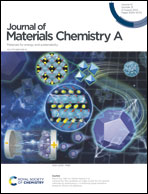Enhanced water permeability in nanofiltration membranes using 3D accordion-like MXene particles with random orientation of 2D nanochannels†
Abstract
Incorporating 2D nanochannels of stacked nanosheets into a polyamide membrane has great potential to improve membrane permeability. However, reported 2D nanochannels are usually perpendicularly aligned to the water transport path direction, which results in an extremely tortuous water flow path and limits membrane performance. Herein, we demonstrated that the 2D nanochannels in 3D accordion-like MXene (AMXene) particles could be facilely incorporated in a polyamide matrix in a random orientation by continuous vacuum assisted assembly and interfacial polymerization on a porous substrate. The incorporation of the AMXene particles can significantly increase the effective area for water collection below the PA layer. In addition, the 2D nanochannel orientation endowed the membrane with much straighter water transport paths. These effects contribute to an ultra-higher membrane water permeance of 24.1 L m−2 h−1 bar−1, which was 210% that of the control membrane without AMXene, and maintaining a higher Na2SO4 rejection of 97.1%. This study provided new insights into rationally engineering nanochannels in polyamide membranes for water treatment.



 Please wait while we load your content...
Please wait while we load your content...